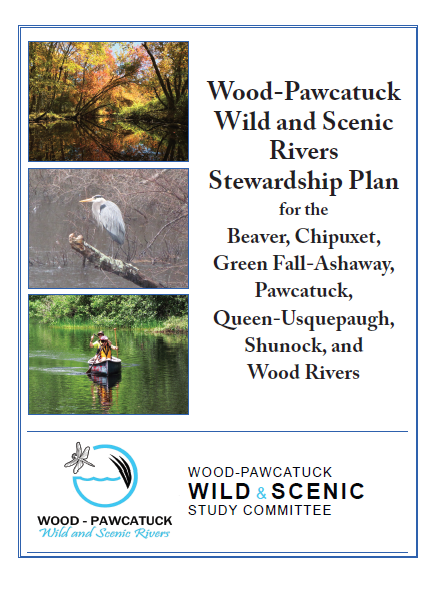Wood-Pawcatuck Wild and Scenic Rivers Stewardship Plan
By the end of 2018, the Study Committee and 12 watershed towns voted to adopt the Wild and Scenic Stewardship Plan. Of particular use to towns and other partners is Chapter 6: Action Strategies for the Future, which contains a list of goals for consideration. In addition to the Plan Appendix A contains the report by Mason and Associates that provides a Summary of Federal, State, Municipal and Tribal Laws, Regulations, Ordinances and Plans. Appendix B contains all the letters of support from the Watershed Towns, State Agencies, Town Committees and Community Partners. Appendix C lists the References, Resources, and Experts consulted to develop the Stewardship Plan. Appendix D contains lists of the State and Federal Threatened, Endangered, and Species of Concern known to be in the Watershed. These documents are the locally-based Stewardship Plan that describes the eligibility and suitability of a Partnership Wild and Scenic River designation for the Beaver, Chipuxet, Green Fall-Ashway, Queen-Usquepaugh, Pawcatuck, Shunock, and Wood Rivers and how they will be protected. Other Reports, documents, meeting agendas and minutes, and various presentations given by or to the Wood-Pawcatuck Wild and Scenic Rivers Study Committee are posted for review.
The Four Values
Outstandlingly Remarkable Values, also known as ORVs or The Values, must be identified to earn the National Wild and Scenic status. The four values of the Wood-Pawcatuck are listed below. For specifics, explore each of the seven Rivers.
- Geology and Hydrology
- Exceptional Ecosystems
- Cultural
- Scenic and Recreation
The Wood-Pawcatuck Wild and Scenic Rivers Study was conducted in cooperation with the National Parks Service and the Wood-Pawcatuck Watershed Association (WPWA). WPWA is a non-profit, conservation organization that is the RI State designated Watershed Council to advocate for the Wood-Pawcatuck Watershed. For more information about WPWA visit the WPWA website.


